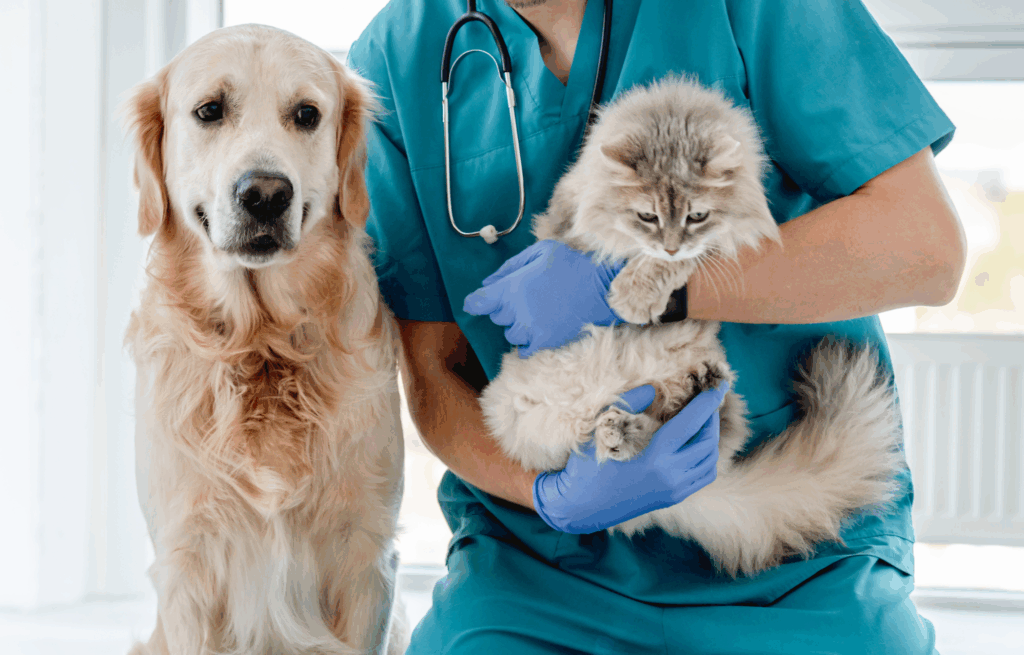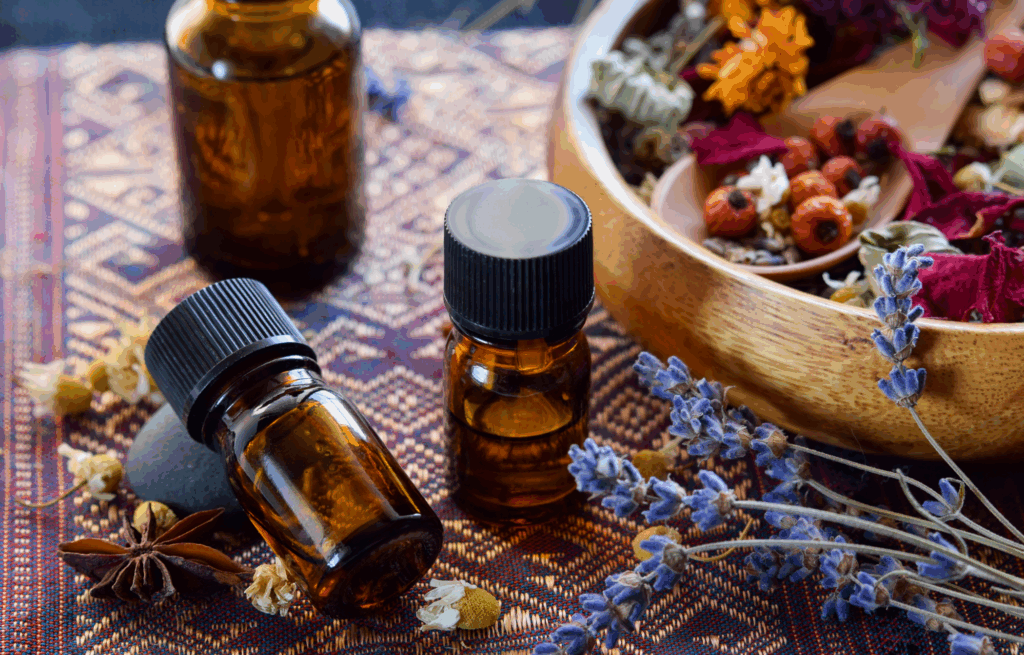Essential oils are powerful plant extracts with well-known benefits for humans—but when it comes to pets, the safety story is very different. Dogs, cats, birds, and small animals have unique sensitivities, and some essential oils can be dangerously toxic—even in tiny amounts. This guide breaks down exactly which oils are safe (and which to avoid), how to use them responsibly, and the signs of toxicity to watch out for—so you can create a safe, soothing environment for all your furry (or feathered) family members.
Cats lack certain liver enzymes (specifically glucuronyl transferase), which are essential for breaking down many common essential oil compounds like phenols and monoterpenes. This makes them far more vulnerable to toxicity than dogs.
Dogs also require caution, especially smaller breeds, but their metabolism can handle a wider range of oils if used properly diluted and in well-ventilated spaces.
Birds, rabbits, guinea pigs, and other small pets have extremely delicate respiratory systems. Even airborne diffusion of strong oils can lead to respiratory distress, neurological symptoms, or death. Because of their small size and high respiratory rate, even minute exposure can have amplified effects.
Avoid using these oils around or on dogs:
These oils may cause vomiting, tremors, liver damage, or nervous system issues in dogs when ingested, inhaled, or absorbed topically.
Cats are especially vulnerable to:
Even diffusing these oils in a closed room can result in respiratory irritation, drooling, loss of coordination, or worse.
The term “natural” does not equal “safe” for pets. Undiluted essential oils can quickly absorb through paws, skin, or nasal tissues and overwhelm an animal’s detox systems. Toxicity can occur even from indirect contact like licking their fur after oils were diffused in the air.

Only use 100% pure, therapeutic-grade oils and dilute properly in a carrier oil or diffuser.
Such safe oils can be beneficial for Anxiety, Joint Support and Minor Skin issues, particularly below:
Diffusing essential oils can be done safely around pets, but only when following strict precautions. Animals are far more sensitive to airborne particles than humans, and improper use can lead to respiratory irritation or worse. Always ensure the room is well-ventilated—open windows are ideal—and never trap a pet in a space where diffusion is happening. Keep the door open so your dog or cat can freely exit if the scent becomes overwhelming. Use only low-output diffusers, and limit diffusion to short intervals of 30 to 60 minutes. Never place the diffuser near your pet’s bedding, food, water bowls, or litter box, as concentrated oils can settle and linger in those areas. Monitor your pet’s behavior during and after diffusion, and avoid using oils overnight or in confined spaces where your pet has no escape route. Safe diffusion is about giving your animal control over their environment, just as you would for a child or sensitive family member.
Topical use of essential oils on pets is highly discouraged and can pose serious health risks. Unlike human skin, a pet’s skin is thinner and more permeable, allowing oils to absorb more quickly—often leading to chemical burns, allergic reactions, or systemic toxicity. Compounding the risk, pets instinctively groom themselves, meaning any oils applied to their fur or paws are likely to be ingested. Even diluted oils can cause harmful effects such as vomiting, drooling, lethargy, tremors, or seizures. Instead of applying oils directly, opt for gentler alternatives like hydrosols—plant-infused floral waters that deliver mild aromatic benefits without the concentrated potency of essential oils. If using essential oil sprays, ensure they are pet-safe and applied only to fabrics, bedding, or areas the animal doesn’t directly touch or lick. Never spray oils onto your pet’s fur, paws, or collar. When in doubt, always consult a holistic or integrative vet before introducing any topical product.
If you love using natural scents around your home but want to keep your pets safe, there are simple, vet-informed ways to create gentle aromatherapy blends that avoid the risks of concentrated essential oils. One great option is a calming room spray. You can mix a soothing hydrosol, such as lavender or chamomile water, with distilled water and add a single drop of organic lavender essential oil to a glass spray bottle. Lightly mist this blend into room corners or onto pet-free fabrics, but never spray it directly on your animal or near their food, toys, or bedding.
For natural flea control, a carefully diluted mix of cedarwood oil and neem oil—blended with aloe vera water or witch hazel—can be safely misted on dog bedding, crate edges, or even around garden perimeters where your dog spends time. This blend is not recommended for cats, who are more sensitive to essential oils. Always ensure dilution follows pet-safe guidelines, and observe your animal’s behavior after each use. These DIY solutions allow you to enjoy natural scents while respecting your pet’s unique sensitivities.

Never assume that what’s safe for a dog is safe for a cat, or vice versa. Even between breeds, size and health status matter.
Ask a holistic veterinarian before using any essential oil blend at home. They can recommend:

As a passionate formulator, dog mom, and animal lover, I’ve witnessed both the healing and harmful sides of natural wellness. My mini Pomeranian, Teddy, is a gentle, sensitive soul—and his tiny size makes me hyper-aware of everything I use around him. I never diffuse essential oils in rooms he sleeps in. Instead, I use only floral hydrosols in water-based diffusers—safe for my child and for Teddy. Years ago, a different pet had a reaction to tea tree oil I diffused unknowingly. That experience changed my entire perspective. Today, I formulate with a protective mindset—for humans and their beloved companions alike. Every RootsGuard product follows strict safety protocols not just for people, but for the animals we love and live with every day.
With care and knowledge, you can enjoy the natural benefits of essential oils while protecting your most loyal companions.
Using essential oils around pets demands care—but understanding how essential oils work, how they’re made, and how to use them properly can empower you to create a truly safe, holistic home. If you’re curious about what essential oils actually are, how to spot quality oils, and the safest ways to incorporate them into your daily life, be sure to read our in-depth guide:
The Truth About Essential Oils: What They Are and How to Use Them Safely →
Some essential oils can be safe for dogs when used with caution. Oils like lavender, frankincense, and ginger are generally considered dog-safe when properly diluted and used in well-ventilated areas. However, many essential oils can be toxic to dogs if ingested or applied directly to their skin. Always consult a holistic or integrative vet before introducing any oils.
Cats are extremely sensitive to essential oils due to their unique liver metabolism. Toxic oils for cats include tea tree, eucalyptus, clove, cinnamon, citrus (lemon, orange, bergamot), peppermint, and pine oils. Even small exposures—topical or inhaled—can result in serious health issues.
Diffusing essential oils around pets can be safe with strict precautions: ensure the room is well-ventilated, allow the pet to leave freely, use low-output diffusers, and diffuse for short periods (30–60 minutes). Never diffuse near your pet’s bedding, food, or litter box.
Vet-approved calming oils include lavender (stress relief), frankincense (grounding), and Roman chamomile (soothing). Always use proper dilution and indirect methods such as diffusing in a well-ventilated space. Hydrosols are a gentler alternative for anxious pets.
Inhaling essential oil vapors can irritate pets’ respiratory systems, especially in cats, birds, and brachycephalic dog breeds. If you diffuse oils, always ensure proper ventilation, short exposure time, and that your pet can exit the area if needed.
If your pet ingests essential oils, contact a vet or pet poison control center immediately. Do not induce vomiting or offer food unless advised by a professional. Look for signs like vomiting, tremors, lethargy, or drooling.
Yes, certain DIY recipes using properly diluted oils can be safe for dogs. Examples include calming room sprays (lavender hydrosol + distilled water) and flea repellents (diluted cedarwood oil on bedding). Never apply essential oils directly to pets.
Tea tree, wintergreen, eucalyptus, peppermint, clove, cinnamon, citrus oils, and ylang ylang are among the most toxic oils for pets. These can cause liver damage, respiratory distress, seizures, and even death if used incorrectly.
Yes, diffusers can harm pets if misused. Poor ventilation, long exposure times, or use of toxic oils can lead to toxicity. Always monitor your pet’s behavior and stop diffusing immediately if you see signs of distress.
Use only pet-safe oils in well-ventilated areas, avoid topical application, store oils securely, and never leave a diffuser running unsupervised. When in doubt, opt for hydrosols or consult a holistic veterinarian.
Wipe off any oil from the fur using a damp cloth with mild soap (no alcohol), ventilate the room, and seek immediate veterinary help. Bring the oil bottle or label with you to aid diagnosis.
Symptoms include vomiting, drooling, unsteady walking, lethargy, difficulty breathing, tremors, and seizures. In cats, hiding or changes in grooming behavior may also signal distress. Treat it as a medical emergency.
Yes. For cats: citrus, clove, and tea tree are highly toxic. For dogs: wintergreen and pennyroyal are dangerous. For birds: even mild exposure to vapors like eucalyptus or peppermint can be fatal. Always research species-specific risks.
Dilution should be 0.25% or less for pets. For example, 1 drop of essential oil in 4 teaspoons (20 mL) of carrier oil. Never apply essential oils undiluted and avoid direct skin or fur contact.
Yes. Oils like eucalyptus, peppermint, or pine can irritate pets’ lungs, especially in cats and small animals. Always diffuse sparingly and ensure pets are not trapped in closed rooms.
Yes, some brands formulate blends specifically for pets, using gentle, diluted ingredients. However, always verify the formulation, check for GC/MS testing, and consult a vet before use.
Trusted sources include the ASPCA, Pet Poison Helpline, holistic vet organizations (AHVMA), and peer-reviewed veterinary journals. Always prioritize vet-reviewed, science-based sources over influencer advice.